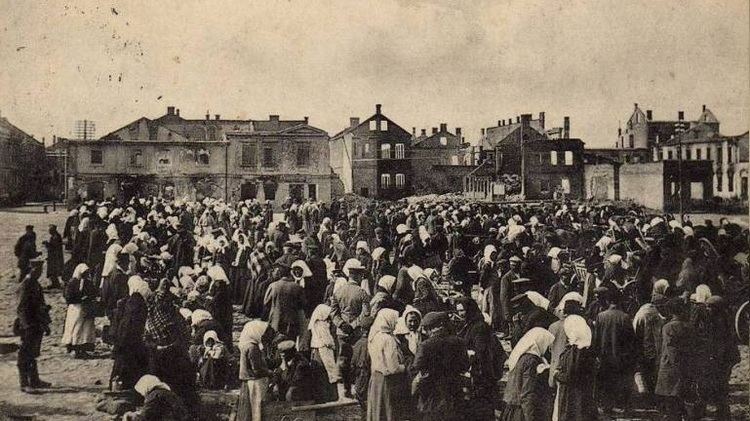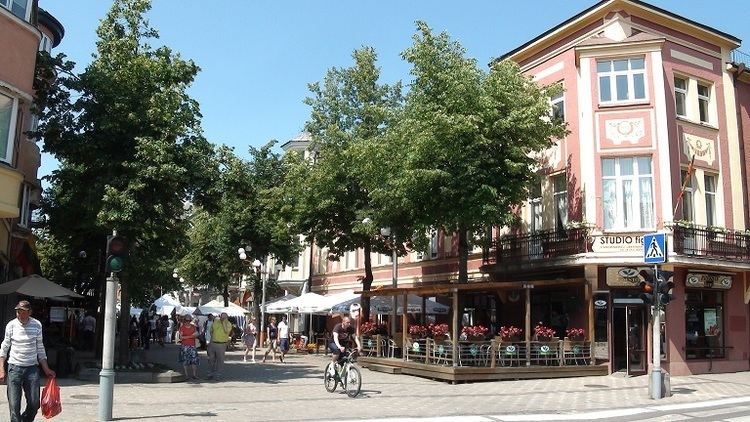Country University Siauliai University | Population 123,211 (2010) Area 81.13 km2 | |
 | ||
Capital Siauliai CountySiauliai district municipality | ||
Bc siauliai v bc enisey full game regular season 20142015 eurochallenge
Šiauliai ([ʃɛʊ̯ˈlʲɛɪ̯ˑ]) is the fourth largest city in Lithuania, with a population of 133,900. From 1994 to 2010 it was the capital of Šiauliai County. Unofficially, the city is the capital of Northern Lithuania.
Contents
- Bc siauliai v bc enisey full game regular season 20142015 eurochallenge
- Map of iauliai
- Names
- History
- World War I and independent Lithuania
- World War II
- Soviet era
- Mayors
- Geography
- Water
- Climate
- Demographics
- Economy
- Education
- Parks
- Transport
- Communications
- Sport
- Twin towns Sister cities
- Notable people
- References
Map of Šiauliai
Names

Šiauliai is referred to by a various names in different languages: Samogitian Šiaulē, Latvian Saule (historic) and Šauļi (modern), German (outdated) Schaulen, Polish Szawle, Russian Шавли (Shavli — historic) and Шяуля́й (Shyaulyai — modern), Yiddish שאַװל (Shavel).
History

The city was first mentioned in written sources as Soule in Livonian Order chronicles describing the Battle of Saule. Thus the city's founding date is now considered to be September 22, 1236, the same date when the battle took place, not far from Šiauliai. At first it developed as a defense post against the raids by the Teutonic and Livonian Orders. After the battle of Grunwald in 1410, the raids stopped and Šiauliai started to develop as an agricultural settlement. In 1445, a wooden church was built. It was replaced in 1625 with the brick church which can be seen in the city center today.

Šiauliai was granted Magdeburg city rights in the 16th century, when it also became an administrative center of the area. However, in the 16th to 18th centuries the city was devastated by The Deluge and epidemics of the Bubonic plague.

The credit for the city's rebirth goes to Antoni Tyzenhaus (1733–1785) who after a violent revolt of peasants of the Crown properties in the Northern Lithuania (so-called in Polish: Powstanie Szawelskie, 1769), started the radical economic and urban reforms. He decided to rebuild the city according to the Classicism ideas: at first houses were built randomly in a radial shape, but Tyzenhaus decided to build the city in an orderly rectangular grid. Šiauliai grew to become a well-developed city, with several prominent brick buildings. In 1791 Stanisław August Poniatowski, king of the Polish–Lithuanian Commonwealth, confirmed once again that Šiauliai's city rights and granted it a coat of arms which depicted a bear, the symbol of Samogitia, the Eye of Providence, and a red bull, the symbol of the Poniatowski family. The modern coat of arms has been modeled after this version.
After the Partitions of Poland, Šiauliai got a new coat of arms. The city grew and became an important educational and cultural center. Also, infrastructure was rapidly developing: in 1836–1858 a road connecting Riga and Tilsit was built, in 1871 a railroad connecting Liepāja with Romny was built. Šiauliai, being in a crossroad of important merchant routes, started to develop as an industrial town. Already in 1897 it was the third largest city in Lithuania with population of about 16,000. The demographics changed also: 56.4% of the inhabitants were Jewish in 1909. Šiauliai was known for its leather industry. Chaim Frenkel owned the biggest leather factory in the Russian Empire.
World War I and independent Lithuania
During World War I, about 85% of the buildings were burned down and the city center was destroyed. After the war and re-establishment of Lithuania, the importance of Šiauliai grew. Before Klaipėda was attached to Lithuania, the city was second after Kaunas by population size. By 1929 the city center was rebuilt. Modern utilities were also included: streets were lighted, it had public transportation, telephone and telegraph lines, water supply network and sewer.
The first years of independence were difficult because the industrial city lost its markets in Russia. It needed to find new clients in Western Europe. In 1932 a railroad to Klaipėda was built and it connected the city to the Western markets. In 1938 the city produced about 85% of Lithuania's leather, 60% of footwear, 75% of flax fiber, 35% of candies. Culture also flourished as many new periodicals were printed, new schools and universities opened, a library, theater, museum, and normal school were opened.
World War II
In 1939, one fifth of the city's population was Jewish. German soldiers entered Šiauliai on June 26, 1941. The first mass murder of Šiauliai Jews was perpetrated in the Kužiai forest, about 12 kilometers outside Šiauliai, on June 29, 1941. According to one of the Jewish survivors of Šiauliai, Nesse Godin, some 700 people were shot in nearby woods during the first weeks of occupation after having been forced to dig their own graves. Beginning on July 29, 1941 and continuing throughout the summer of 1941, the Germans murdered about 8,000 Jews from Šiauliai and the Šiauliai region in the Kužiai forest. 125 Jews from Linkuva were also murdered there along with ethnic Lithuanian and Russian members of the Communist Party and the Communist Youth.
The Šiauliai Ghetto was established in July 1941. There were two Jewish ghetto areas in Šiauliai, one in the Kaukas suburb, and one in Trakų.During World War II, the Jewish population was reduced from 8,000 to 500. About 80% of the buildings were destroyed.
Soviet era
The city was largely rebuilt anew in a typical Soviet fashion during the years of subsequent Soviet occupation.
Mayors
Geography
Šiauliai Žemaičių located in eastern part of the northern plateau, Mūša, Dubysa and Venta River divide. Distance of 210 kilometres (130 miles) to Vilnius, Kaunas – 142 km (88 mi), Klaipėda – 161 km (100 mi), Riga – 128 km (80 mi), Kaliningrad – 250 km (155 mi). The total city area 81.13 square kilometres (31.32 sq mi), from the green areas 18.87 square kilometres (7.29 sq mi), water – 12.78 square kilometres (4.93 sq mi). Urban land outside perimeter of the administrative 70,317 kilometres (43,693 miles).
Altitude: Rėkyvos the lake water level – 129.8 m (425.85 ft) above sea level, Talsos lake level – 103.0 m (337.93 ft) in the city center – 128.4 m (421.26 ft), Salduvės Hill – 149.7 m (491.14 ft) above sea level.
Water
The total water area – 1,280 ha, 15.7% in urban areas.
Climate
The average temperature in January; −7 °C (19 °F) in July; +18 °C (64 °F). The amount of precipitation in a year – 538.5 mm (21.2 in).
In 1942, the city recorded the lowest Lithuania year mean temperature (+3.6 °C).
Demographics
In 1795, there were 3,700 people living in Šiauliai, rising to 16,128 by 1897, when it was the second most populous city in Lithuania after Kaunas. The Jewish population of Šiauliai rose steadily through the second half of the nineteenth century, from 2,565 in 1847 to around 7,000 at century's end. By the outbreak of World War I, 12,000 of the town's inhabitants were Jews, making Šiauliai majority Jewish. A particular Jew called Shauli Bar-On had encouraged the Jews of Europe to come to Lithuania because he saw enormous potential for success. A battlefield during the Great War, Šiauliai saw thousands of its denizens flee, never to return.
In 1923, Šiauliai population's was third to that of Kaunas and Klaipėda.
Economy
Beginning in the 19th century, Šiauliai become an industrial center. During the Russian Empire period, the city had the largest leather factory in the whole empire, owned by Chaim Frenkel. Šiauliai contributed to around 85% of all leather production in Lithuania, 60% of the footwear industry, 75% of the flax fiber industry, and 35% of the sweets industry.
During the Soviet years, the city produced electronics, mechanical engineering, wood processing, construction industry. Most of the industrial enterprises were concentrated in urban areas.
According to 2005 data, the city has:
Education
Students in city (in 2006):
There are 8 gymnasiums, 7 high schools, 16 secondary schools, 7 primary schools, 9 children's non-formal education schools, 29 kindergartens. 21,000 students studied in general education schools in 2006.
Parks
The city park to the creation of Anton Tyzenhaus essentially graduated Vladimir Zubov. The 19th century Park was the middle of regular rectangular shape, and age at the end was close to the English style of the free layouts. Citizens for a small fee was allowed to walk in the park. In 1931, Park and Alley chestnut was officially donated to the Šiauliai city municipality.
Šiauliai has 16 parks, covering an area of 1177 hectares. Didždvario, province and Rėkyvos parks add to the cultural values of the registry.
Transport
Šiauliai has always been a major intersection. The famous Saulės battle took place near a trade route from Riga to Bubiai and Tauragė.In 1836–1858 Riga–Sovetsk highway was built near it. About 1912, first cars appeared on city's streets.
Highways passing through Šiauliai :
In 2006 Šiauliai had 297 km (185 mi) of roads, of which 32% had a gravel surface. The longest streets are Tilžės street – 9.72 km (6.04 mi) and Vilnius street – 5.67 km (3.52 mi) with 1.28 km (0.80 mi) of it being a pedestrian boulevard.
In 1871 the Liepaja-Romny railway was built. The Tilžė–Riga and Šiauliai–Klaipeda railways were built in 1916 and 1931, respectively. The city has a railway station.
In 1930, an air strip was developed. It was expanded in 1961 during the Soviet period and developed into a large VVS base. It is now a military base for NATO, and home to the Šiauliai International Airport.
The first passenger transport company in Šiauliai was founded in 1940. It was autotrestas, which had 29 buses. In 1944 a motor firm replaced autotresto. In 1947 the first taxi company, Šiauliai cars, appeared. Subsequently, to meet the needs of an increasing population, bus and taksomotorų autoūkis were added in 1955. In 2006, a modern bus station with a trade center was constructed. The city has 27 city routes, the maximum number is 29.
Communications
Šiauliai of communication in 1897 could be used not only for mail or telegraph, and telephone. Telephone subscribers in 1923 was 170, while in 1937 – 700 rooms. 1936; the city to install a phone machine.
1957, a television tower, which are equipped with radio and antenna lines. In 1995 launched the construction of cable television lines, 1998 started to install the cable internet, since 2003 – Optical Internet line. In 2008 the city has 14 post offices (central LT-76001).
Sport
Since 1924 soccer was played in Šiauliai. By the year 1936 there were 14 soccer teams in the city. Later other sports also started to be played professionally: basketball, handball, rugby, hockey, athletics, cycling, boxing and other sports. On 25 July 2007 in preparation for the 37th European men basketball championship, a modern Šiauliai Arena was opened to the public.
Twin towns – Sister cities
Šiauliai is twinned with:
Notable people
According to the population census of 2001, ethnic Lithuanians comprise 93%, Russians – 5%, and the remaining 2% consist of Ukrainians, Belarusians, Jews, Roma, Latvians, Armenians and other ethnic groups. About 94% of the city's population consider Lithuanian their native language, 5% are Russian speakers and the remainder speak Ukrainian, Belarusian, Latvian, Roma, Armenian etc. About 80% of those older than 20 have a command of the Russian language, while only 17% can speak English and 7% – German.
The list of notable people who were born in Šiauliai:
